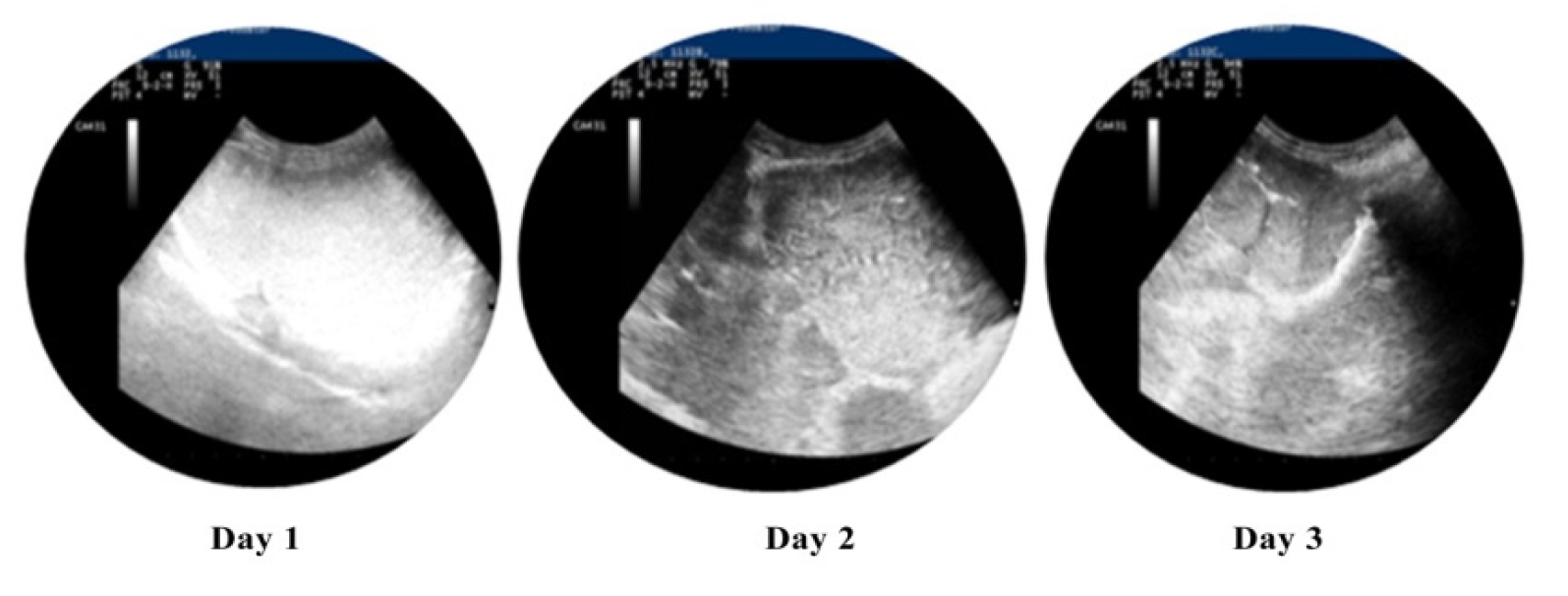Ultrasonographic assessment of effect of neostigmine on abomasal atony in young calves
DOI:
https://doi.org/10.56825/bufbu.2023.4233968Keywords:
Bubalus bubalis, buffaloes, neostigmine, abomasum, atony, ultrasonographyAbstract
Present communication was focused on the ultrasonographic evaluation of the prokinetic effect of neostigmine in buffalo calves with abomasal atony. Six buffalo calves were selected for the study with absence of rumination, loss of feed intake, mild distended abdomen, achezia and frequent history of laying down and getting up with reduced rumen motility. Abomasal atony was confirmed by the ultrasonographic assessment of the abomasum motility. Calves were administered with injection neostigmine 0.02 mg/kg body weight slow intravenously along with 500 ml of 0.9% normal saline under the ultrasonographic monitoring. Abomasal motility was initiated by 18 to 42 minutes and complete abomasal motility was noticed by 150 to 180 minutes after administration of medications. Clinical improvement was noticed on the third day of therapy and efficacy of the neostigmine was noticed by ultrasonography. Present study concludes that neostigmine has prokinetic effect in buffalo calves with abomasal functional motility disorders. Ultrasonography is the best tool for assessment of abomasal motility without any adverse reactions and complications.
Downloads
Metrics
References
Constable, P.D., H.S. Done, K.W. Hinchcliff and W. Grünberg. 2017. Veterinary Medicine. A Textbook of the Diseases of Cattle, Horses, Sheep, Pigs, and Goats, 11th ed. Elsevier Ltd., Netherlands. p. 502-510.
Erickson, N. and S. Hendrick. 2011. Sand impactions in a Saskatchewan beef cow-calf herd. Canadian Vet. J., 52(1): 74-76. 10.
Oman, R.E., R.N. Streeter and E.J. Reppert. 2016. Left displacement of the abomasum in 4 beef calves. J. Vet. Intern. Med., 30(4): 1376-1380. DOI: 10.1111/jvim.14353
Reddy, B.S., G. Vijayakumar, G.A. Balasubramaniam, S. Sivaraman and S. Kathirvel. 2018. Evaluation of efficacy of neostigmine and azithromycin as motility modifiers in the medical management of functional ileus in twenty cows - A pilot study. Indian Vet. J., 95(8): 47-50.
Reddy, B.S., G. Vijayakumar, G.A. Balasubramaniam, S. Sivaraman and S. Kathirvel. 2020. Efficacy of neostigmine and azithromycin in buffaloes with functional ileus. Buffalo Bull., 38(4): 649-652. Available on: https://kukrdb.lib.ku.ac.th/journal/BuffaloBulletin/search_detail/result/395223
Reddy, B.S. and S. Sivajothi. 2020. A study on abomasal atony in buffalo calves. Pharma Innovation Journal, 9(9): 169-171. Available on: https://www.thepharmajournal.com/archives/2020/vol9issue9S/PartD/S-9-9-41-875.pdf
Steiner, A. 2003. Modifiers of gastrointestinal motility of cattle. Vet. Clin. N. Am. Food A., 19(3): 647-660. DOI: 10.1016/s0749-0720(03)00051-3a
Wittek, T. and P.D. Constable. 2005. Assessment of the effects of erythromycin, neostigmine, and metoclopramide on abomasal motility and emptying rate in calves. Am. J. Vet. Res., 66(3): 545-552. DOI: 10.2460/ajvr.2005.66.545









.png)








